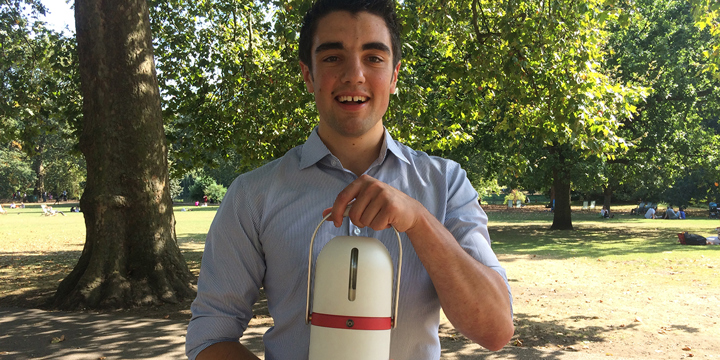The problem:
In 2015, an estimated 19.4 million children worldwide failed to receive routine immunisation services, with more than 60% of these living in developing countries. Figures suggest that an additional 1.5 million deaths could be avoided if global vaccination systems improve. And, current vaccine programmes in developing countries do not meet the international standards for temperature safe vaccine distribution which leads to vaccines losing potency.
The solution:
ISOBAR works by using a chemical process to provide a long term cooling effect for vaccine delivery.
A mix of Ammonia and Water is heated in a lower pressure vessel. The ammonia vaporises and separates from the water into the upper chamber where it is trapped by a valve. It remains trapped until the cooling effect is needed.
The design engineer behind ISOBAR is William Broadway, who just graduated from Loughborough University this year with a first class honours degree in Industrial Design and Technology. William will be given £2,000 to develop his idea, which he plahttps://jda.prd.digital.dyson.cloud/news/isobar/ns to put towards building more prototypes and applying for patents.
William Broadway said: “I am so pleased that the technology can get a bit of the limelight. Winning the UK James Dyson Award gives me the confidence to pursue my invention with my whole heart in the knowledge that yes, I can actually make this device and that it could have a great impact for the benefit of thousands of people”.
Jack Lang, Fellow at the Judge Business School at Cambridge University, co-founder and chair of Raspberry Pi and UK James Dyson Award judge 2016 says: “Isobar is a brilliant invention. It solves a real problem and is a complete, well-thought-through system.”
ISOBAR and the UK national runners up will now continue in the next round of the James Dyson Award as they go up against the best entries from across the globe, before they are rounded down to the final 20. The international winner will be announced on the 27th October, a title which is awarded along with a £30,000 prize, to help the inventor further developing their idea.
UK National Runners Up:
Telestretch
Kieran Moralee, Product Design, Nottingham Trent University
Problem: The design of stretchers used in military combat have gone largely unchanged – bulky to carry and time consuming to assemble.
Solution: Telestretch is a compact spinal board that can be fitted to a military rucksack. It is easily adjustable through its telescopic extension mechanism, quickly allowing it to respond to a casualty.
Hipsterlce
Joshua de Gromoboy, Engineering, University of Cambridge
Problem: In hot countries, laptop cooling systems are ineffective and laptops run inefficiently.
Solution: HipsterIce is a low cost, non-powered cooler that gives laptops five hours of efficient use every day.
Kodama
Charles Leclercq, Innovation Design Engineering, Royal College of Art
Problem: Playing is a form of learning. With the onset of digital media, tangible interaction is removed from what kids now consider as playing.
Solution: Kodama is a tangible interface for creating 3D animations by moving toys with your hands, allowing to satisfy the children’s needs for screens, while at the same time enforcing human to human interaction
Stent Tek Ltd
Sorin Bopa, Bioengineering, Imperial College London
Problem: 2.5 million patients worldwide with kidney failure have to undergo surgery to receive dialysis treatment – a painful and costly procedure.
Solution: StentTek is a minimally invasive catheter system that can connect two independent vessels which achieves the same results as the surgical approach, even offering potentially better outcomes.



Share this page on